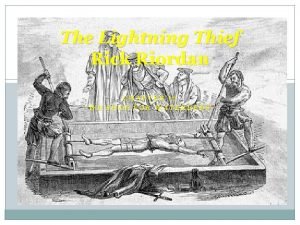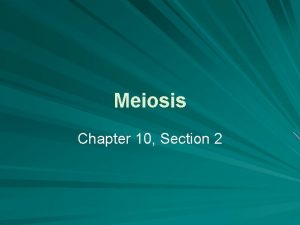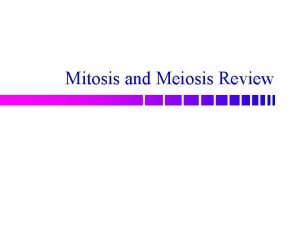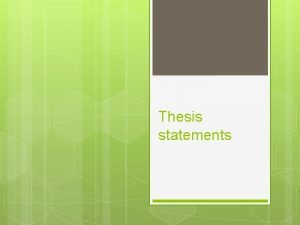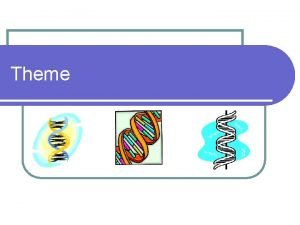MEIOSIS Chapter 10 Section 1 Main Idea Meiosis























- Slides: 23

MEIOSIS Chapter 10 Section 1

Main Idea Meiosis is a reduction division and produces haploid gametes.

Thinking Questions How does the reduction in chromosome number occur during meiosis? What are the stages of meiosis? What is the importance of meiosis in providing genetic variation? Copyright © Mc. Graw-Hill Education

Chromosome and Chromosome Number • Characteristics such as hair color, eye color, etc. , are called traits. • The instructions for each trait are located on chromosomes, in the nucleus of cells. • DNA is organized in segments called genes that control protein production. Each chromosome contains hundreds to thousands of genes.

Chromosome and Chromosome Number Homologous chromosomes • Human cells have 46 chromosomes, or 23 pairs (one contributed by each parent). • The chromosomes that make up the pairs are called homologous chromosomes. • Homologous chromosomes are the same length, same centromere position, and carry genes for the same traits.

Chromosome and Chromosome Number Haploid and diploid cells • To maintain the same number of chromosomes from generation to generation, organisms produce gametes – sex cells with half the number of chromosomes. • The symbol n can be used to represent the number of chromosomes in a gamete. • A cell with n chromosomes is called a haploid cell. • A cell that contains 2 n chromosomes is called a diploid cell.

Meiosis I • • Meiosis is a type of cell division that reduces the number of chromosomes in a cell and produces gametes. Involves two consecutive cell divisions, meiosis I and meiosis II

Meiosis I Interphase • Chromosomes replicate in S phase.

Meiosis I Prophase I • Pairing of homologous chromosomes occurs. • Each chromosome consists of two sister chromatids.

Meiosis I Prophase I • • • As homologous chromosomes condense, they are bound together in a process called synapsis, which allows for crossing over. Crossing over – chromosomal segments are exchanged between a pair of homologous chromosomes. Crossing over produces exchange of genetic information.

Meiosis I Metaphase I • Chromosome centromeres attach to spindle fibers. • Homologous chromosomes line up as a pair at the equator.

Meiosis I Anaphase I • Homologous chromosomes separate and move to opposite poles of the cell. • The chromosome number is reduced from 2 n to n when the homologous chromosomes separate.

Meiosis I Telophase I • Chromosomes reach the cell’s opposite poles. • Cytokinesis occurs.

Meiosis II Prophase II • A second set of phases begins as the spindle apparatus forms and the chromosomes condense.

Meiosis II Metaphase II • Chromosomes are positioned at the equator. • Meiosis II involves a haploid number of chromosomes.

Meiosis II Anaphase II • Sister chromatids are pulled apart at the centromere by spindle fibers and move toward the opposite poles of the cell.

Meiosis II Telophase II • The chromosomes reach the poles, and the nuclear membrane and nuclei reform.

Meiosis II Cytokinesis • Cytokinesis results in four haploid cells, each with n number of chromosomes

The Importance of Meiosis • Mitosis consists of one cell division that produces two identical cells. • Meiosis consists of two cell divisions that produce four haploid daughter cells that are not genetically identical. • Meiosis results in genetic variation.

The Importance of Meiosis provides variation • During metaphase I, the chromosomes line up randomly at the equator. • Gametes end up with different combinations of chromosomes. • Genetic variation also is produced during crossing over and during fertilization, when gametes randomly combine.

Sexual Reproduction v. Asexual Reproduction Asexual reproduction • The organism inherits all of its chromosomes from a single parent. • The new individual is genetically identical to its parent. Sexual reproduction • The organism inherits chromosomes from two parents. • Rate of beneficial mutations is faster. • Beneficial genes multiply faster over times than they do for asexual organisms.

Meiosis!!

Thinking Questions How does the reduction in chromosome number occur during meiosis? What are the stages of meiosis? What is the importance of meiosis in providing genetic variation? Copyright © Mc. Graw-Hill Education
 Example of main idea
Example of main idea What is central idea
What is central idea Main idea and controlling idea
Main idea and controlling idea What is the difference between topic and theme
What is the difference between topic and theme Unrelated sentences in paragraphs
Unrelated sentences in paragraphs Concept mapping chapter 10 meiosis 1 and meiosis 2
Concept mapping chapter 10 meiosis 1 and meiosis 2 Meiosis and genetic variation answer key
Meiosis and genetic variation answer key Chapter 10 section 1: meiosis
Chapter 10 section 1: meiosis What is chapter 17 about in the lightning thief
What is chapter 17 about in the lightning thief Chapter 10 section 10.2 meiosis worksheet answer key
Chapter 10 section 10.2 meiosis worksheet answer key Meiosis vs mitosis anaphase
Meiosis vs mitosis anaphase Meiosis 1
Meiosis 1 What is the difference between mitosis and meiosis 2
What is the difference between mitosis and meiosis 2 Telophase 1
Telophase 1 Expository preaching vs. exegetical preaching
Expository preaching vs. exegetical preaching Wacana penulisan
Wacana penulisan Meiosis has 8 main phases true or false
Meiosis has 8 main phases true or false Topic sentence structure
Topic sentence structure Two types of main idea
Two types of main idea Main ideaa
Main ideaa Title thesis statement
Title thesis statement Whats the difference between main idea and theme
Whats the difference between main idea and theme What is central idea? *
What is central idea? * What is the theme in the giver
What is the theme in the giver








